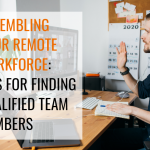How’s your onboarding process working for you when hiring employees?
If you’re anything like most business owners today, you may be putting a great deal of time and resources into hiring, only to find that at the end of the day, you’re coming up short. You sift through candidates, trying to find the best ones for the job, but you feel that it’s guesswork, at best.
Candidates who look promising on paper tend to look a lot less promising when it comes time for the interview. And the ones that make it past the interview stages, well, often it seems like they’re not even close to qualified. What’s going wrong?
Maybe you’ve learned the hard way that while it’s easy to say “you’re hired.” It’s not nearly as much fun to realize a few weeks after onboarding, that you’ve hired the wrong person for the job.
A Gallup study found that only 12% of employees believe their company is efficient at onboarding employees. That means a whopping 88% do not believe their company is recruiting effectively, which suggests many companies are failing at the general process.
So what’s going wrong? How can you ensure that the people you hire (or enlist as contract workers) are actually qualified. Not just vaguely qualified!
Great employee onboarding can improve employee retention by 82%. It’s worth putting some time into implementing a process that’ll help you to sift through candidates more efficiently, and find hires who are perfect for the role at hand. In this article, I’ll show you the number one reason why new hires don’t work out, and some other common reasons as well, along with a few tips for hiring right: the first time.
The #1 Reason Why New Hires Don’t Work Out
Often onboarding is mistaken for paper-pushing, where too much emphasis is placed on processes and paperwork, such as payroll, work benefits, and insurance forms. While these are all essential steps, they are not the core of the hiring process.
Companies often forget that one of the most important aspects of onboarding is integrating the employee smoothly into the business.
In my experience, I’ve found that one of the main reasons new hires don’t work out is because the employee (or contract worker) was a poor match for the role.
All too often, as employers, we rely on resumes and basic questions to try to understand an applicant’s personality. This is particularly true during the initial interviews and pre-boarding process. But it’s impossible to fully gauge the personality of a new hire at this stage, as it’s likely they are not yet revealing their true nature.
Instead, a lot of applicants will present themselves in a way they think a business wants them to be versus how they truly are, which almost always comes out in the end.
Hiring employees based ONLY on a stellar resume, without digging into their personality and whether they actually fit into the organization, is one of the biggest mistakes a business can make when hiring. It is often a huge reason why new hires fail. You cannot expect a resume to answer all your questions and, even more importantly, correctly indicate the true personality of a potential hire.
It’s been said that a stellar resume doesn’t mean that the applicant is qualified for the job; it just means that the applicant knows how to create great resumes or is simply really great at interviewing.
Speaking of interviews: often in interviews, a candidate is saying what they think you will want to hear versus what they really think. By using personality tests when recruiting candidates, you can make it harder for them to gauge what response you’re looking for and will be able to extract more of their true habits.
These tools are becoming increasingly popular by recruiters because they allow you to truly get an idea of an applicant’s personality before taking any further steps, instead of making your selection based on assumptions in transitional interviews. Using personality tests makes it harder for them to gauge what response you are looking for, and you are able to extract more of their true habits.
Sure, these tools cost money. But hiring (and then firing) the wrong hires has a cost too, and usually, it’s a lot bigger.
6 MORE Reasons for New Hire Failure and How to Combat Them
Effective hiring is made up of more than just one recruiting process and doesn’t happen overnight. The entire process takes months and starts even before the first interview. However, the most common onboarding blunders are usually oversights and gaps in information between the new hires and the company.
The following six mistakes are other common reasons for new hire failure.
(Source)
Vague or Unclear Job Descriptions
It’s crucial that businesses advertise the job correctly to get the right kinds of applicants. By failing to do so, you could attract candidates that are completely unsuited and lack the essential requirements for the job.
When getting ready to advertise the position, a good idea is to have a discussion with the parting employee about what their specific duties were and if anything central to the position has changed since it was last listed. If it’s a new position, look at how other companies are advertising similar roles and go from there.
If you’re after long-term employees, getting information such as the job description right from the beginning is a must. Not only will it make the entire hiring process smoother, but it provides the new hires with the opportunity to excel in their roles from the very start!
In addition, the biggest mistake small companies make when hiring is trying to hire a jack of all trades. Someone who is good at research probably isn’t the best salesperson. Someone who understands Facebook ads really well probably isn’t going to be the best at writing sales copy. Really understanding what jobs and tasks need to be offloaded will help you get clearer on the type of person you need to hire.
Information Overload on Day One
A lot of new hire failures are due to overloading newly hired employees on their first day or week. After a month or more of paperwork and pre-boarding, it’s normal to let your enthusiasm take over and want your new employee to dive right into the job. However, overwhelming your new hires, even more than they already are, by putting too much on their plates early on can be a disservice and is another major reason why new hires fail.
Instead of pushing business processes into the first day or week, such as management and co-worker introductions and initial training, try to push them out over two or three weeks to allow for a smoother introduction.
(Source)
Another tactic to combat new hire overload could be to produce a new employee FAQ sheet, as marketer Marc Holliday suggests, which could answer questions such as: when is payday? How do I apply for leave? And what is our work-from-home policy?
Also, don’t assume that because you showed them something once, that they will immediately get it. Have resources that they can lean on, such as standard operating procedures (SOPs) and training videos that they can refer back to often to make sure they can absorb information at their own pace, not yours.
Giving Too Much Too Quickly or Not Giving Enough at All
Like bombarding your new hires on the first day with company information, you can just as easily discourage your employees by setting them off to work too soon, or worse, not giving them enough work at all. This usually comes down to a lack of goal setting, leaving employees with no sense of direction or measurement for success.
However, such a problem is easily fixed by having hiring managers sit down with the employee sometime in the first week to map out specific expectations and goals for the position. It’s best to do it during the first few days or weeks to ensure both your business and new hire are on the same page.
Lack of Company Structure, Organization, and Culture
Many companies have shifted the way they work in the last few years to allow more flexible work-from-home policies and even work attire. But no matter how relaxed a workplace has become, it’s important not to treat onboarding with the same looseness.
A lack of structure and organization can be incredibly detrimental when bringing on new hires and can result in employees feeling unsupported or unsure of whether they fit into the culture.
New hires will likely get a feel for how the company operates from talking to co-workers and being in the office. But that’s not to say conversations about work attire, work-from-home policies, and other important information should not be had at all. It’s important to establish such policies to ensure you’re both on the same page.
Another tactic is to use productivity tools. For example, if your business communicates from a platform like Trello or Slack, think about setting up a channel for new people to ask questions about how the business operates and get to know others on their team.
Neglecting Feedback
It’s important that you establish a friendly feedback environment with your new hire from the start. By not leaving any room for your new hire to give feedback. Furthermore, neglecting feedback also can result in low employee engagement and trust, which can cause nightmares for day-to-day business.
To solve this, make sure you establish several different methods for your new hires to input feedback, such as allowing space for two-sided conversations by asking questions such as, “Was this information helpful?” Then avoiding defensiveness when feedback is given.
Not Addressing Cultural and Generational Differences
Your new hires and older staff are likely going to have some cultural or generational differences. For example, the hire of someone in their 20s is likely to be more interested in ways the company could help out with their student loans repayments, and they may require more mentoring. Whereas an employee in their 50s is more likely seeking support for their retirement funding and health insurance.
It’s important that the hiring process recognizes cultural and generational differences, to ensure you’re not only creating an environment where everyone feels equally valued but also supported depending on their specific situations or life stages.
Information and expectations like this should be discussed early on in the hiring process with hiring managers and is vital to setting up a healthy relationship between the company and new staff members.
Get our Top 7 Reasons Why New Hires Don’t Work Out and What to Do About It - Worksheet delivered right to your inbox.
The Next Step: Using Onboarding Tools to Combat Failure Rates
One technique that many businesses are turning to when it comes to new hires is using onboarding software and personality tests.
Using digital HR tools during onboarding will not only save your company time, but they can work wonders for correctly uncovering the true personality of a candidate and assessing their skills, which are all crucial components to whether they will be a good fit for the job.
Today there’s plenty of different HR software available to suit your hiring needs, whether that be to automate paperwork or correctly assess the personality of new hires.
Here are some good options:
The Predictive Index
Predictive Index is software to help you evaluate how well a candidate will fit into a company. The tool allows you to evaluate cognitive abilities, personality, traits, and behavioral tendencies during the hiring process and then uses that data to help you make a more informed, and more objective hiring decision.
(Source)
Used by thousands of businesses worldwide, including IBM and Subway, the tool is incredibly popular and a great method to truly uncover a candidate’s personality and whether they fit with the company’s vision. Pricing information for this software is available on request.
Adaface
Adaface is a skills assessment tool to help you find the right qualified candidate for the job, and is one of the more sophisticated AI-powered tools on the market right now. Used by companies such as Amazon and PayPal in their hiring process, Adaface offers features such as coding tests, aptitude tests, and psychometric tests to help with the first round of interviews.
Pricing starts from as little as $180 a year based on your company size and needs.
Athena Quotient
Another popular tool is Athena Quotient, which is primarily used for judging personality. The tool is highly flexible and adaptable, allowing you to create your own tests and design quizzes to properly access whether a candidate is right for the job.
(Source)
The tool is suitable for both big and small companies and offers per-assessment pricing, as well as a subscription model starting from $500 a month.
Codility
If you’re looking to hire a new developer, Codility is the perfect onboarding assessment tool for you. Codility offers online code tests to screen engineers and help make evidence-based hiring decisions. It also allows you to compare candidates’ scores and provides individualized assessments to narrow down your potential candidates.
Pricing varies depending on the scale and type of your recruitment. For a quote, get in touch with Codility directly.
Software and onboarding tools are becoming more and more popular, especially as companies become more digitally minded. The integration of AI software and assessment tools such as those listed can greatly aid you when conducting new hires by not only saving you time, and correctly assessing your candidates. But the cost of hiring and firing someone far outweighs the cost of services like these.
Of course, other free options also exist, such as asking applicants to state their results for the Career Personality Profiler and Enneagram tests found on Truity.com, or their Myers-Briggs results or Career Values test from 16 Personalities. If you will be using this information, you need to clearly establish with your team how the results will fit with the visions and goals of your team and what will not work.
The main trick to avoid a future new hire failure is to approach the hiring process attentively, and keep in mind that candidates aren’t always what you might think. In most cases, they’ll be focused on telling you what YOU want to think, though! At the end of the day, good onboarding tools are worth the time and effort spent, and are often key to helping you find the perfect candidate for the job.
What about you? Have you found some good strategies to ensure that you hire/contract the right people? I’d love to hear your thoughts and experience in the comments.
And be sure to get in touch today if you’d like help scaling your company. Reach out for your FREE consultation and let’s put together a plan that’ll help you to reach the next stage in your business’ growth and development.
Get our Top 7 Reasons Why New Hires Don’t Work Out and What to Do About It - Worksheet delivered right to your inbox.







